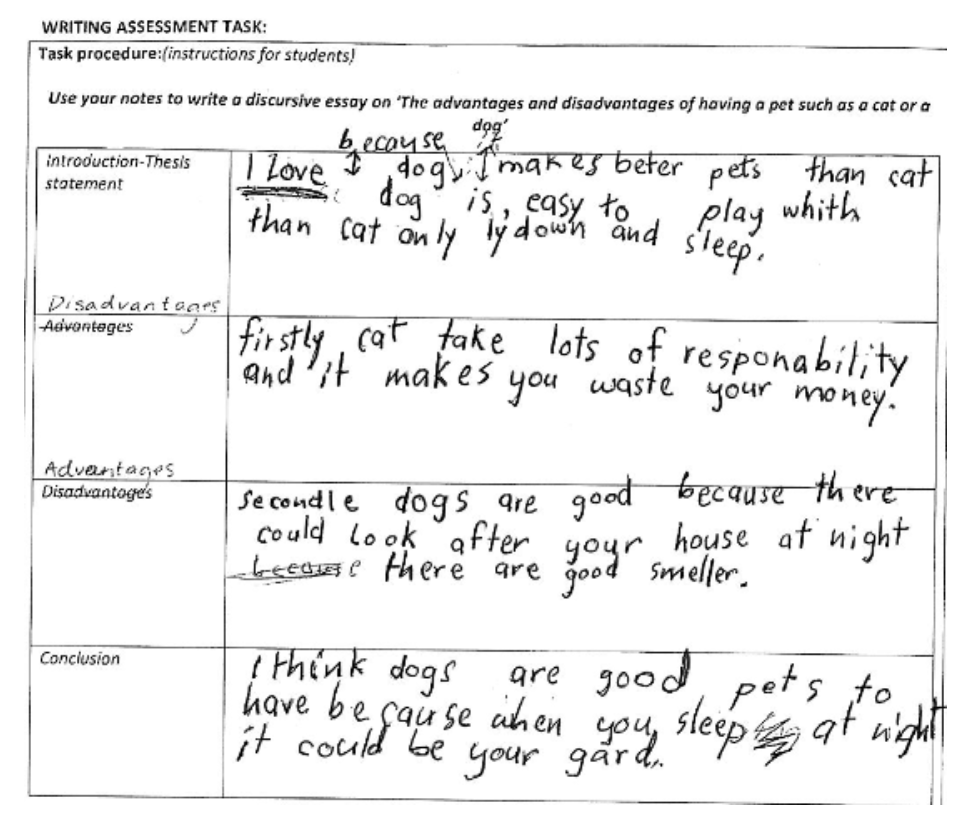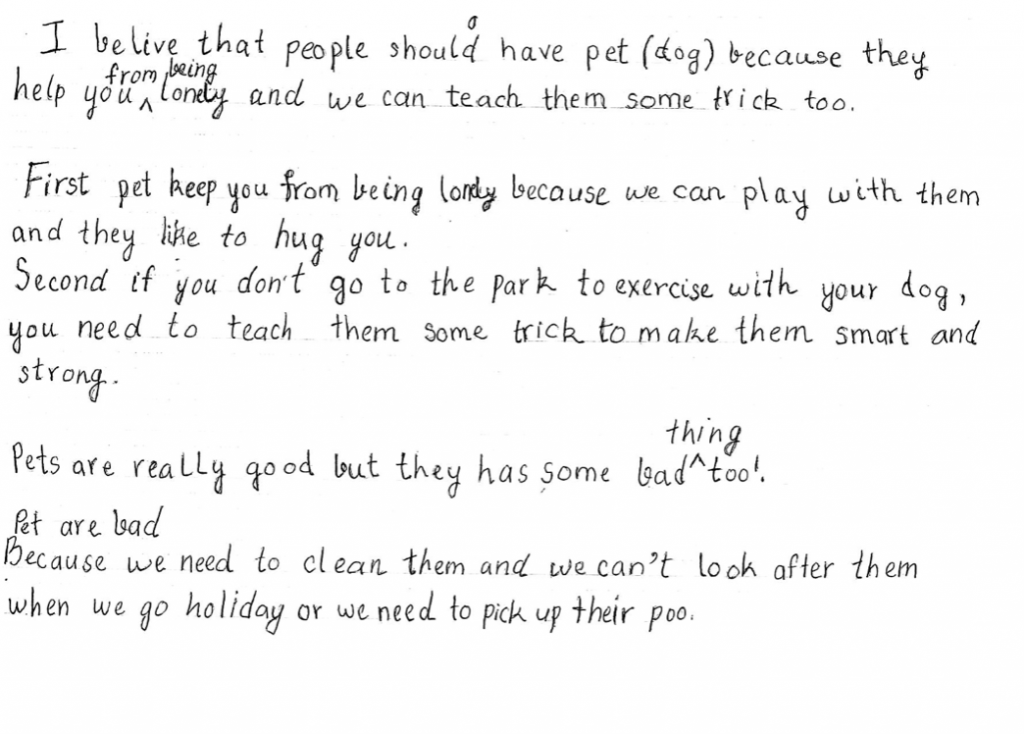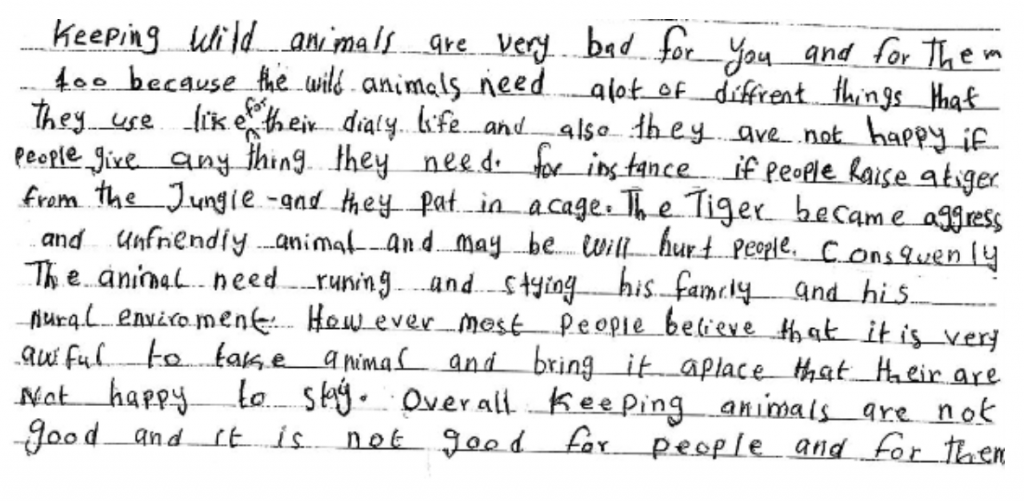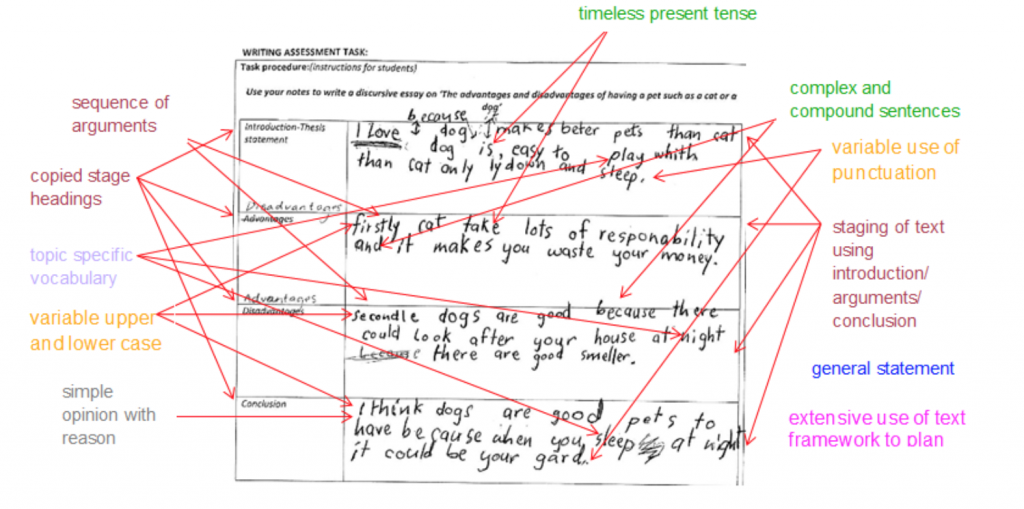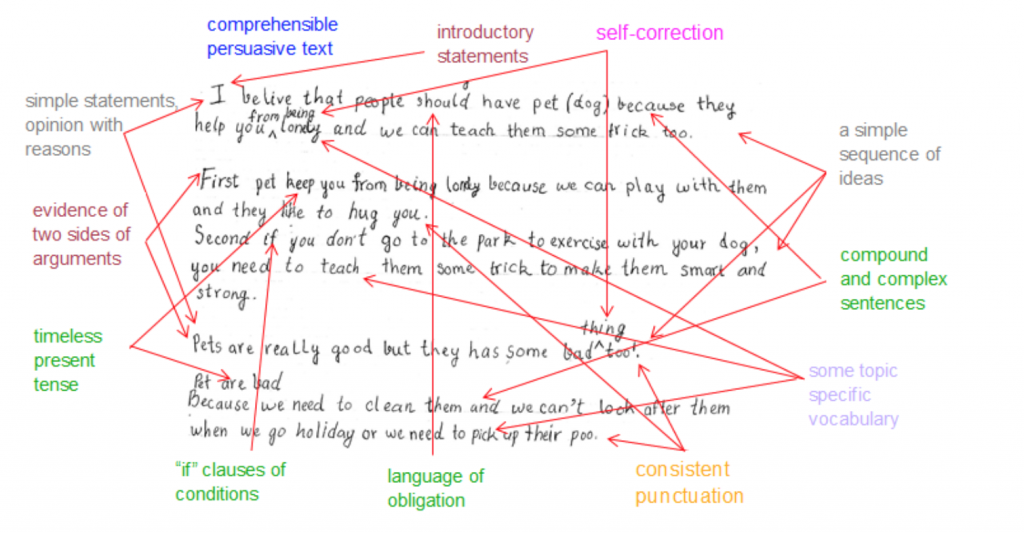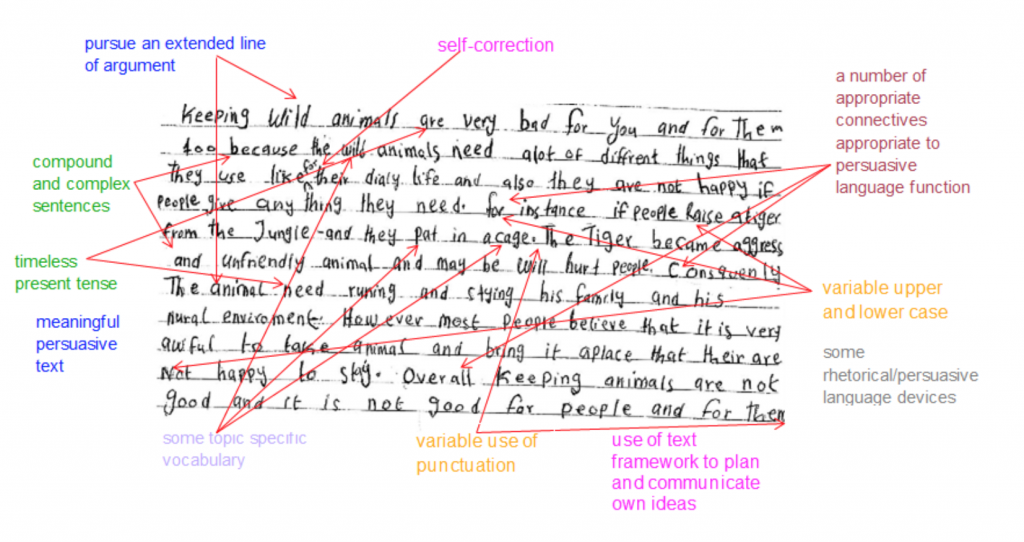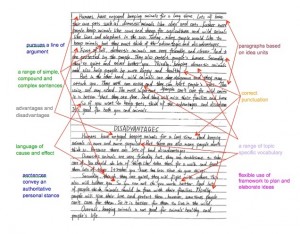12. The advantages and disadvantages of having a pet
Please click on the toggles below to navigate through information on this assessment task and reveal the links for downloading task materials.
Task details |
|
| Name of writing assessment task | The advantages and disadvantages of having a pet |
| EAL curriculum level range | B2, B3, C2, C3, C4 |
| Text orientation | Persuasive |
| Task type | Extended response |
Task specification |
|
| Purpose | To assess students’ ability to write an essay presenting arguments for and against a topic supported by ideas and information. |
| Description | Students write an essay about the advantages and disadvantages of having a pet, such as a cat or a dog. |
| Assumed knowledge and description |
The language of argumentation:
Linguistic structure of an argument:
4. Vocabulary: English words relating to having a cat or a dog |
Learning/teaching context |
|
| Language centre/mainstream class | EAL Support |
| Subject/key curriculum objectives, outcomes | English |
| Topic/teaching unit | Writing discursive essays to present both sides of an argument |
| Assessment conditions |
|
| Notes |
|
Task implementation |
|
| STAGE | ACTION STEPS |
| Pre-assessment activity |
|
| Assessment activity |
|
| Post-assessment activity |
|
TEAL Writing Task 12 – unmarked criteria sheet [PDF]
TEAL Writing Task 12 – unmarked criteria sheet [Word]
An explanation of the purpose, nature and use of criteria sheets is available at 4. Using the assessment criteria.
The purpose and nature of the task
The expressing of opinions and use of argument with supporting reasons or evidence is a prominent text type in public discourse in Australia, as well as in academic study in English and humanities subjects. This task involves formal argumentative discourse and linking of opinions to evidence in relation to a topic students may have experience of or know something about, owning a domestic pet such as a cat or a dog. The task provides teachers with assessment information about their EAL students' skills in expressing opinions and presenting support for a point of view in a piece of formal writing.
The task requires students pay some attention to presenting arguments to both support and contradict a point of view. It also expects students to express an opinion on the topic. There is scope for the students to do this within an essay that either strongly supports a particular opinion and therefore has a partisan quality in relation to the topic, or which has a more detached tone and is more descriptive of the arguments presented on the issue, and less on supporting particular opinions. There is a complex interrelationship between the ways arguments are presented and the ways they are used to support an opinion and downplay alternative opinions. The intention of this task is more to look at EAL students' skills in presenting points of view and supporting arguments, rather than the more sophisticated skills involved in a powerful texts intended to contribute to argument and change opinions.
Commentary
The range of samples illustrate different levels of skill in presenting reasons to support arguments. They do this within different levels of argument, some present argument within a strong expression of a particular point of view, while others are more detached, providing description of arguments that may be used to support different opinions.
Biographical information:
Year: 3
Home language: Vietnamese
Commentary
The sample shows an understanding of the task and an ability to write a simple argument on the disadvantages and advantages of having a pet dog.
The text shows that the student is able to express simple opinions with supporting reasons and is able to organise them within a given text structure framework. The student uses simple, compound, complex sentences employing clauses of reason.
The student uses timeless present tense to express general statements.
The student is able to use full stops to mark sentences correctly but has variable use of appropriate upper and lower case.
The student is reliant on extensive use of text model/framework to accomplish the task.
The marked criteria sheet shows that the student meets most criteria at level 1 of performance and some at level 2.
The student’s language use in this task is consistent with the descriptions of students at Level C2, Victorian Curriculum F-10 EAL.
Using this assessment for further learning
(Select the points you think are currently of most importance to the student.)
The sample draws attention to the student’s need to develop persuasive language for comparing, contrasting and conceding opposing arguments to a thesis. It also highlights the student’s sensitivity to and ability to learn from modelled texts.
This language can be modelled and developed by having the student complete an elaborated cloze text based on the student’s own sample which targets contrastive argumentation words or phrases such as ‘although’, ‘however’, ‘on the other hand’. This process could then be repeated with reduced degrees of modelled support.
Biographical information:
Year: 3
Home language: Vietnamese
Commentary
The sample shows an understanding of the task and an ability to write a two-sided argument on the disadvantages and advantages of having a pet dog.
The text shows that the student is able to state and justify a simple thesis and is able to organise arguments within a given text structure framework. The student uses compound and complex sentences employing clauses of reason and condition.
The student uses timeless present tense to express general statements.
The student is able to use standard spelling and punctuation.
The student employs the stimulus text to accomplish the task.
The sample shows a text that best fits the criteria in .
The marked criteria sheet shows that the student meets most criteria at level 2 of performance and some at level 3.
The student’s language use in this task is consistent with the descriptions of students at Level C2, Victorian Curriculum F-10 EAL.
Using this assessment for further learning
(Select the points you think are currently of most importance to the student.)
The sample shows the student’s ability to write a simple cohesive two-sided argument text but highlights their need to develop a wider repertoire of argumentation language and rhetorical/persuasive devices.
This language can be modelled and developed by getting the student to complete an elaborated cloze text based on the student’s own sample which targets a range of persuasive language functions and devices such as addition (‘moreover’), exemplification (‘for instance’), contrast (‘however’, on the other hand’), and concession (‘although’). This process could then be repeated with reduced degrees of modelled support until students have mastered the language.
Biographical information
English language centre (secondary)
Commentary
The sample shows an understanding of the task and an ability to write a quite elaborate argument and to and justify a single point of view relating to the topic. However it is framed in terms of keeping wild animals as pets, rather than disadvantages and advantages of having a pet dog.
The text shows that the student can sustain a line of argument using a range of persuasive language functions and devices. While there are features of persuasive writing present in the text, the text itself is a single paragraph, which has an introductory sentence that is not completely satisfactory as a topic sentence.
The student uses compound and complex sentences and timeless present tense to express opinions. However, there are also some problems of sentence construction, and errors of subject-verb agreement.
The student uses standard spelling and variable punctuation.
The student employs the stimulus text to accomplish the task.
The marked criteria sheet shows that the student meets some criteria at level 3 of performance, while some are also at level 2 and even level 1.
The student’s language use in this task is consistent with the descriptions of students at Level C2, Victorian Curriculum F-10 EAL.
Using this assessment for further learning
(Select the points you think are currently of most importance to the student.)
The sample shows the student’s ability to elaborate and justify a single point of view, employing a wide repertoire of argumentation language and rhetorical/persuasive devices. The sample also highlights their need to develop skills in organising the text into coherent paragraph units and an ability to consider two sides of an argument.
These skills can be developed by having the student complete text deconstruction and reconstruction exercises around persuasive texts which involve identifying paragraph units within a single run-on text, and sequencing and labelling paragraph texts to make a single coherent text. At the same time, these texts could also model two-sided argumentation.
Biographical information:
English language centre (secondary)
Commentary
While the sample shows an understanding of the communicative purpose of the task and of persuasive texts, and an ability to sustain and support a balanced two-sided discussion of an issue, the text has problems of cohesion and structure. The first paragraph, is not labelled, seems to be a set of arguments for keeping domestic animals, but the second paragraph headed 'DISADVANTAGES' presents opposing arguments.
The text shows that the student can sustain arguments using a repertoire of persuasive language functions and devices at sentence level. However, the organisation of the text is not so strong and it lacks cohesion as a sustained presentation of a point of view, despite effective use of a range of sentence-level ways of expressing ideas and giving supporting reasons.
The student uses compound and complex sentences and timeless present tense to communicate arguments.
The student uses standard spelling and punctuation.
The student employs the stimulus text to accomplish the task.
The marked criteria sheet shows that the student meets many criteria at level 3 of performance, and some at level 4.
The student’s language use in this task is consistent with the descriptions of students at Level C3, Victorian Curriculum F-10 EAL.
Using this assessment for further learning
(Select the points you think are currently of most importance to the student.)
The sample shows the student’s ability to write a balanced two-sided discussion of an issue in response to a stimulus text. The competence and sophistication of the student’s writing at sentence levels suggest that the student’s needs lie in the area of consolidating and extending skills in structuring a persuasive texts.
These skills could be developed by asking the student to clearly identify the argument they want to present and re-write it using the following structure:
| Paragraph 1 |
Identification of the topic: State point of view Argument in support of point of view and supporting reasons. |
| Paragraph 2 | Arguments against your point of view, and supporting. |
| Paragraph 3 | Summary of how reasons for your point of view outweigh the reasons against your point of view. |

